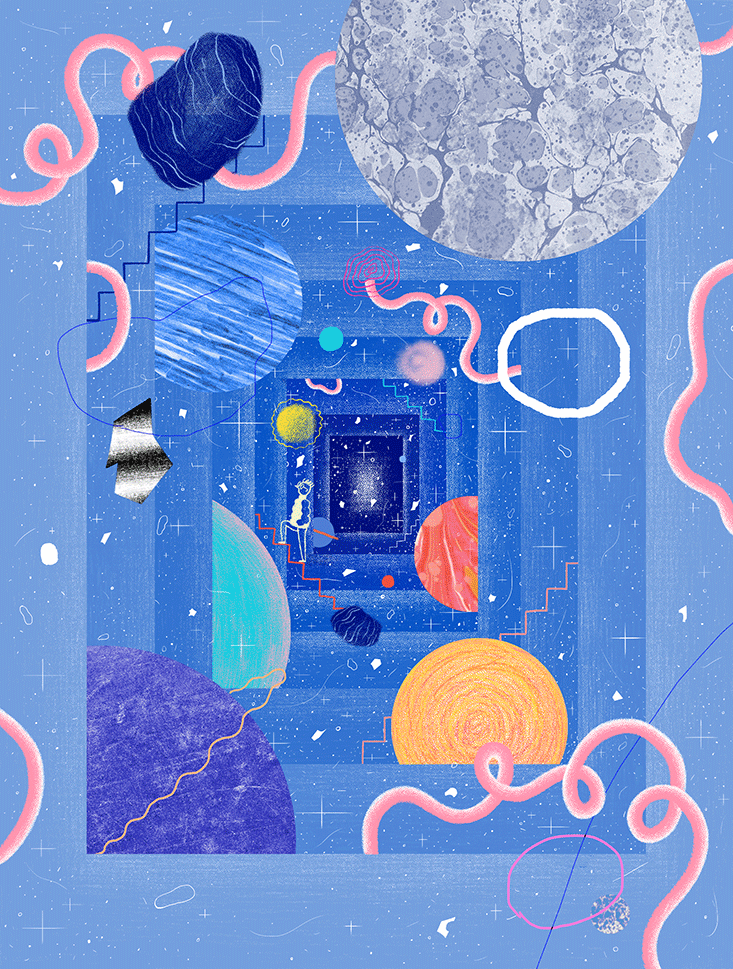A rocket powered by kerosene and liquid oxygen and carrying a scientific observatory blasted off into space at 10:49 p.m., March 6, 2009 (by local calendars and clocks). The launch came from the third planet out from a G-type star, 25,000 light-years from the center of a galaxy called the Milky Way, itself located on the outskirts of the Virgo Cluster of galaxies. On the night of the launch, the sky was clear, with no precipitation or wind, and the temperature was 292 degrees by the absolute temperature scale. Local intelligent life forms cheered the launch. Shortly before the blastoff, the government agency responsible for spacecraft, named the National Aeronautics and Space Administration, wrote in the global network of computers: “We are looking at a gorgeous night to launch the Kepler observatory on the first-ever mission dedicated to finding planets like ours outside the solar system.”

The above account might have been written by an intelligent life form located on exactly the kind of distant planet that Kepler would soon begin to search for. Named after the Renaissance astronomer Johannes Kepler, the observatory was specifically designed to find planets outside our solar system that would be “habitable”—that is, neither so near their central star that water would be boiled off, nor so far away that water would freeze. Most biologists consider liquid water to be a precondition for life, even life very different from that on Earth. Kepler has surveyed about 150,000 sun-like stellar systems in our galaxy and discovered over 1,000 alien planets. Its enormous stockpile of data is still being analyzed.1
If the Gobi Desert represents all of the matter flung across the cosmos, living matter is a single grain of sand.
For centuries, we human beings have speculated on the possible existence and prevalence of life elsewhere in the universe. For the first time in history, we can begin to answer that profound question. At this point, the results of the Kepler mission can be extrapolated to suggest that something like 10 percent of all stars have a habitable planet in orbit. That fraction is large. With 100 billion stars just in our galaxy alone, and so many other galaxies out there, it is highly probable that there are many, many other solar systems with life. From this perspective, life in the cosmos is common.
However, there’s another, grander perspective from which life in the cosmos is rare. That perspective considers all forms of matter, both animate and inanimate. Even if all “habitable” planets (as determined by Kepler) do indeed harbor life, the fraction of all material in the universe in living form is fantastically small. Assuming that the fraction of planet Earth in living form, called the biosphere, is typical of other life-sustaining planets, I have estimated that the fraction of all matter in the universe in living form is roughly one-billionth of one-billionth. Here’s a way to visualize such a tiny fraction. If the Gobi Desert represents all of the matter flung across the cosmos, living matter is a single grain of sand on that desert. How should we think about this extreme rarity of life?
Most of us human beings throughout history have considered ourselves and other life forms to contain some special, nonmaterial essence that is absent in nonliving matter and that obeys different principles than does nonliving matter. Such a belief is called “vitalism.” Plato and Aristotle were vitalists. Descartes was a vitalist. Jöns Jakob Berzelius, the 19th-century father of modern chemistry, was a vitalist. The hypothesized nonmaterial vital essence, especially in human beings, has sometimes been called “spirit.” Sometimes “soul.” The eighth-century B.C. Egyptian royal official Kuttamuwa built an 800-pound monument to house his immortal soul and asked that his friends feast there after his physical demise to commemorate him in his afterlife. The 10th-century Persian polymath Avicenna argued that since we would be able to think and to be self-aware even if we were totally disconnected from all external sensory input, there must be some nonmaterial soul inside of us. These are all vitalist ideas.
Modern biology has challenged the theory of vitalism. In 1828, the German chemist Friedrich Wöhler synthesized the organic substance urea from nonorganic chemicals. Urea is a byproduct of metabolism in many living organisms and, previous to Wöhler’s work, was believed to be uniquely associated with living beings. Later in the century, the German physiologist Max Rubner showed that the energy used by human beings in movement, respiration, and other forms of activity is precisely equal to the energy content of food consumed. That is, there are no hidden and nonmaterial sources of energy that power human beings. In more recent years, the composition of proteins, hormones, brain cells, and genes has been reduced to individual atoms, without the need to invoke nonmaterial substances.
Yet, I would argue that most of us, either knowingly or unknowingly, remain closet vitalists. Although there are moments when the material nature of our bodies screams out at us, such as when we have muscle injuries or change our mood with psychoactive drugs, our mental life seems to be a unique phenomenon arising from a different kind of substance, a nonmaterial substance. The sensations of consciousness, of thought and self-awareness, are so gripping and immediate and magnificent that we find it preposterous that they could have their origins entirely within the humdrum electrical and chemical tinglings of cells in our brains. However, neuroscientists say that is so.
A universe without comment is a universe without meaning.
Polls of the American public show that three-quarters of people believe in some form of life after death. Surely, this belief too is a version of vitalism. If our bodies and brains are nothing more than material atoms, then, as Lucretius wrote two millennia ago, when those atoms disperse as they do after death, there can be no further existence of the living being that once was.
Paradoxically, if we can give up the belief that our bodies and brains contain some transcendent, nonmaterial essence, if we can embrace the idea that we are completely material, then we arrive at a new kind of specialness—an alternative to the specialness of “vitalism.” We are special material. We humans living on our one planet wring our hands about the brevity of our lives and our mortal restraints, but we do not often think about how improbable it is to be alive at all. Of all the zillions of atoms and molecules in the universe, we have the privilege of being composed of those very, very few atoms that have joined together in the special arrangement to make living matter. We exist in that one-billionth of one-billionth. We are that one grain of sand on the desert.
And what is that special arrangement deemed “life?” The ability to form an outer membrane around the organism that separates it from the external world. The ability to organize material and processes within the organism. The ability to extract energy from the external world. The ability to respond to stimuli from the external world. The ability to maintain stability within the organism. The ability to grow. The ability to reproduce. We human beings, of course, have all of these properties and more. For we have billions of neurons connected to each other in an exquisite tapestry of communication and feedback loops. We have consciousness and self-awareness.

The two tramps in Samuel Beckett’s Waiting for Godot, placed on a minimalist stage without time and without space, waiting interminably for the mysterious Godot, capture our bafflement with the meaning of existence.
Estragen: “What did we do yesterday?”
Vladimir: “What did we do yesterday?”
Estragen: “Yes.”
Vladimir: “Why … (Angrily) Nothing is certain when you’re about.”
Of course, there are questions that do not have answers.
But if we can manage to get outside of our usual thinking, if we can rise to a truly mind-bending view of the cosmos, there’s another way to think of existence. In our extraordinarily entitled position of being not only living matter but conscious matter, we are the cosmic “observers.” We are uniquely aware of ourselves and the cosmos around us. We can watch and record. We are the only mechanism by which the universe can comment on itself. All the rest, all those other grains of sand on the desert, are dumb, lifeless matter.
Of course, the universe does not need to comment on itself. A universe with no living matter at all could function without any trouble—mindlessly following the conservation of energy and the principle of cause and effect and the other laws of physics. A universe does not need minds, or any living matter at all. (Indeed, in the recent “multiverse” hypothesis endorsed by many physicists, the vast majority of universes are totally lifeless.) But in this writer’s opinion, a universe without comment is a universe without meaning. What does it mean to say that a waterfall, or a mountain, is beautiful? The concept of beauty, and indeed all concepts of value and meaning, require observers. Without a mind to observe it, a waterfall is only a waterfall, a mountain is only a mountain. It is we conscious matter, the rarest of all forms of matter, that can take stock and record and announce this cosmic panorama of existence before us.
I realize that there is a certain amount of circularity in the above comments. For meaning is relevant, perhaps, only in the context of minds and intelligence. If the minds don’t exist, then neither does meaning. However, the fact is that we do exist. And we have minds. We have thoughts. The physicists may contemplate billions of self-consistent universes that do not have planets or stars or living material, but we should not neglect our own modest universe and the fact of our own existence. And even though I have argued that our bodies and brains are nothing more than material atoms and molecules, we have created our own cosmos of meaning. We make societies. We create values. We make cities. We make science and art. And we have done so as far back as recorded history.
In his book The Mysterious Flame (1999), the British philosopher Colin McGinn argues that it is impossible to understand the phenomenon of consciousness because we cannot get outside of our minds to discuss it. We are inescapably trapped within the network of neurons whose mysterious experience we are attempting to analyze. Likewise, I would argue that we are imprisoned within our own cosmos of meaning. We cannot imagine a universe without meaning. We are not talking necessarily about some grand cosmic meaning, or a divine meaning bestowed by God, or even a lasting, eternal meaning. But just the simple, particular meaning of everyday events, fleeting events like the momentary play of light on a lake, or the birth of a child. For better or for worse, meaning is part of the way we exist in the world.
And given our existence, our universe must have meaning, big and small meanings. I have not met any of the life forms living out there in the vast cosmos beyond Earth. But I would be astonished if some of them were not intelligent. And I would be further astonished if those intelligences were not, like us, making science and art and attempting to take stock and record this cosmic panorama of existence. We share with those other beings not the mysterious, transcendent essence of vitalism, but the highly improbable fact of being alive.
Alan Lightman is a physicist, novelist, and professor of the practice of the humanities at the Massachusetts Institute of Technology. His latest book is Screening Room.






























